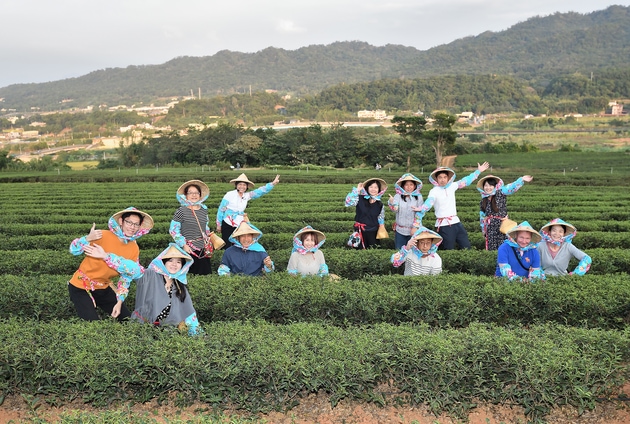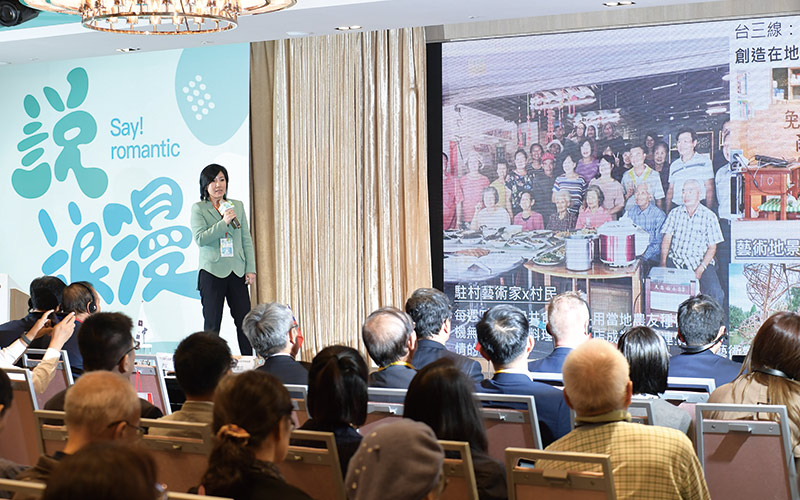Working Hand in Hand with Germany, Japan and Korea to “Say Romantic”
Hakka Communities Open Their Doors to International Tourism

Source:Hakka Affairs Council
In this age of globalization, international visitors come not only to see famous sites, but also to enjoy the uniqueness of daily life in cultures across the world. Tourism affords opportunities for both cultural and intercultural appreciation, evincing Taiwan’s robust and diverse cultural treasures, including traditional Hakka culture and its modern revival, allowing for local enrichment as a treasured resource for blossoming tourism.
Views
Hakka Communities Open Their Doors to International Tourism
By Integrated Communication DepartmentSponsored Content
To enhance the global visibility of the Taiwan Romantic Route 3, the Hakka Affairs Council and the Taiwan Romantic Guesthouse Tourism Development Association are cooperating with romance themed Creative Placemaking experts from Germany, Japan and Korea visiting Taiwan.
In addition to conducting visits and exchanges, a "Romantic International Route" tourism cooperation memorandum of understanding (MOU) was signed, and a long-term cooperation mechanism between multinational institutions was established to assist each other in disseminating tourism information and continue collaborating through tourism, industry, culture, and talent exchanges and cooperation to promote tourism industry upgrading and the quality of tourism services.
At the same time, the Say Romantic International Tourism Forum and Banquet was held, inviting domestic and foreign tourism and creative experts and related industry players and artists for an in-depth dialogue and exchanges. The interaction among all was very enthusiastic, with a view to further accelerating the Taiwan Romantic Route 3 by enhancing attraction for tourists from all over the world to discover the beauty of the Hakka communities.
 Photo by Hsu, Yu-Kai
Photo by Hsu, Yu-Kai
It is also worth noting that this MOU signing in Taiwan included not only the renowned international tourism entity from Germany, the ROMANTISCHE STRAßE, but also includes the Daegu Tourism Association of Korea, and the Japan Aisaika Organization from Tsumagoi Village in Japan. This collaboration will proceed from localities and cities to the international aspect, through exchange and cooperation with tourism promotion units at different levels, locations, routes, and areas to interweave romantic tourism shared by the world. The strategic partners in the initiative will not only be studying tourism issues from an international level, but also looking forward to giving back to the localities, individuals, places, and organizations who can learn from overseas successful experiences and add new value to urban tourism! We have also specially extended an invitation to the Japan Aisaika Organization to serve as an international tourism consultant to the Taiwan Romantic Guesthouse Tourism Development Association, providing tourism promotion, local innovation, and recommendations from Japan’s tourist outreach experience, to strengthen our interactive learning in the tourism and hospitality fields.
The Taiwan Romantic Route 3 Shines Forth with The Native Values of Our Homeland
The 150km span of the The Taiwan Romantic Route 3 extends from the northwest corridor of Taiwan across four major counties weaving together 10 Hakka communities with the stories of their history, industry and traditional culture and humanities, for a romantic travel experience replete with authentic encounters.
Deputy Minister Yiong Cong-ziin of the Hakka Affairs Council noted during the Forum that creating the the Taiwan Romantic Route 3 is an important initiative of the administration of President Ing-wen Tsai. Over the past three years, the Hakka Affairs Council has promoted the education and heritage transmission among artists and musicians in the Hakka language and culture in Hakka communities.
The effort has also witnessed formation of the 270km long Raknus Selu Trail, while continually considering how to present the romantic ambiance of the Hakka communities. He quoted the 18th-century German scholar Gottfried von Herder, whose romanticism believed that "the cultural atmosphere of the self should be recognized by retrieving the natural relationship between people and the land." Indeed, the experts and scholars and all those endeavoring in the Taiwan Romantic Route 3 are engaged in just such a dialogue with our own land, so that we can start to understand and cherish the land under our feet, and display our culture all the more confidently.
 Photo by Hsu, Yu-Kai
Photo by Hsu, Yu-Kai
In the past, Taiwan’s Hakka have been an invisible minority, as the Director of the Taiwan Romantic Route 3 Office, Chen Bang-Jen, notes, that over the past thirty years of the Hakkanese Cultural Revival movement, we have witnessed the renaissance of Hakka culture greatly enriching Taiwan’s vibrant cultural diversity. The Taiwan Romantic Route 3 effort focuses on a policy of organically synergizing the Taiwan Highway Route 3 region by eliciting the local humanities and history, to unearth and present the authentic stories with their unique cultural characteristics. Minister Chen explained: “On its surface, the Cultural Festival appears aimed at reviving Hakka culture, as a government policy initiative, but in fact it represents the deep significance of finding and recognizing our self-worth and authentic identity through unearthing the deep roots of our cultural heritage, while affording our originally invisible native Hakka communities the opportunity to emerge as Taiwan’s Hakka and the world’s Hakka!”
 Photo by Hsu, Yu-Kai
Photo by Hsu, Yu-Kai
The Authentic Hakka Experience for Everyday Romance
How shall we symbiotically unify the renaissance of Hakka culture and industry to yield tourism value? Lulu Chuang, Executive Director of the Taiwan Romantic Guesthouse Tourism Development Association, expressed the view that the critical factor is “self-confidence”, and her strong belief that the Taiwan Romantic Route 3 culture is very much valuable to explore, as it will allow tourism to holistically integrate with daily life, so that the authentic local lifestyles become a unique tourist experience and ambiance.
The Taiwan Romantic Route 3 has many intrinsic traditions which symbiotically coalesce with contemporary living, as the local populace reinvent their narrative relation with their homeland environment, ultimately emerging as an ideal success story for innovative local tourism development. For example, there is the Taiwan Highway Route 9 Beilin 3rd Village, where over 700 villagers developed the “Finding Farm Mud Game”and the “Hundred Ghosts Midnight Festival” both of which enjoy attendance from over one thousand visitors annually, or participants numbering more than the total of the local citizenry.
Have you read?
♦ The Hakka Cultural Renaissance Memories Along a Mountain Route
♦ 'Longtan, My Home, In Dreams You Visit and Linger in My Soul'
♦ Tea, Camphor Laurel, and Sugar Cane
There is also the 12 liao Artist-in-Residence program in conjunction with the populace promoting local art highlights integrated into the lifestyle, to serve as popular FB checking-in sites, and encouraging local youth to return to their hometowns, as well as stimulating the locals to fraternize closely, while creating previously unheard of tourism opportunities.
 Photo by Hsu, Yu-Kai
Photo by Hsu, Yu-Kai
Lulu Chuang emphasized “With the government’s resource integration in cooperation with local innovative design and strategic brand planning, it is possible to synergize diverse cohorts to create new modes of experiencing local highlights during the tourism experience, to unleash the tremendous inchoate potential so everyone can enjoy the value of Hakka culture.” Indeed, the newly emerging cultural innovation tourism experience is precisely arising among the Hakka communities as they blossom again.
Germany’s Romantische Straße Preserves The Romantic Appearance of Century Old Villages
If one is to speak about romantic themed tourism itineraries and experiences, it is not possible to avoid a discussion of the century old villages of Germany’s Romantische Straße. This special MOU invited participation of Jürgen Wünschenmeyer representing the Romantische Straße Touristik Arbeitsgemeinschaft Gbr, and he feels that sharing their world renowned experience replete with its 19th century charm and historical tourism value, with its highly regulated conservation of the quaint villages appearance and culture, and restoration or renovation of castles or exterior walls, ensuring the continued authenticity of the appearance of these hundred year old communities. Also, the Romantische Straße maintains its pristine natural environs along with the pure and friendly local residents. Jürgen also noted that in this visit to Taiwan, he has realized just how warm and welcoming the traditional Hakka community residents are, much like those of the Romantische Straße in his homeland, with a local ambiance unique to their character, which is one of highly attractive aspects which is so appealing to tourists seeking authenticity.
 Photo by Hsu, Yu-Kai
Photo by Hsu, Yu-Kai
Moreover, Jürgen emphasized: “the sense of belonging and a shared common purpose and objective is also imperative, as when developing a tourism route, everyone must share a sense of commonality toward the product, along with support from local community leaders and mayors, ensuring the citizenry are fully able to amply participate in enjoying the expected benefits of development and a shared voice in its planning.”
Korean Alley Tours Experiencing The Past in Daily Living in The Byways
This MOU also includes participating of the Daegu Tourism Association represented by its Director, Kim Tae Kyou, who shared about the successful experience of their “Romantic Capitol- Daegu”. Daegu is the only heritage city which went unaffected by the Korean War in the 1950s and was able to preserve its authentic heritage, with rich Korean historic resources.
The Daegu Tourism Association began planning its “Alley Tours” in 2007, with five routes for tourism development plans, by revitalizing the previously seemingly abandoned alleys and byways to their former pristine historic status, and emerging as renowned heritage tourism highlights, allowing the new generation to experience the authentic lived experience of the 1950s. The Daegu annual tourism volume experienced explosive growth from its original 287 visitors to 2.22 million tourists in 2017, bringing along with it many youth entrepreneurs returning to their hometown, and reinvigorating the magical appeal of Daegu with great vitality.
“In Korea, one finds traditional alleys in many places, and they do not seem to have special tourism value or to warrant a visit, but if the alleys give narration to a story, it might be worth engaging and listening to!”, Kim Tae Kyou shared that the secret to the success of the Alley Tours lies in the unique attraction of these modern history sites to youth under thirty, who have been enticed to the many young entrepreneurial stores, creating a vibrant appearance in these tourism alleys.
In Taiwan we also find a plethora of historic alleys and byways, where the locals who pass them by everyday do not feel anything particularly special, but for youth in their twenties and thirties, these places not seen in their textbooks, reflect their own sense of a source of identity and a living history, which is also reflective of the lifestyles their parents and grandparents once lived. The attraction of local tourism is precisely in that we can revisit places we once considered commonplace, but are now quite extraordinary.
 Photo by Hsu, Yu-Kai
Photo by Hsu, Yu-Kai
The Samurai Legend Which Inspired The Aisaika Culture with Syntegrity to Form Japan’s Most Successful Innovative Tourism Project
Tsumagoi Village in Japan is home to the Aisaika Organization which promotes a pro-family “culture of respecting one’s wife” as the basis for their lived romanticism. The Aisaika Organization’s Deputy Director Kosuge Ryuta explained that the entity is not focused on tourism, but in expressing concern for society and aspiring to create harmonious family relations among spouses for a“happiness growth curve ”. To promote this vision, the Organization united with the Tsumagoi Village’s environment famed for producing cabbage, and the bronze statute in the community memorializing a Samurai who yearned for his deceased wife, and the renowned Japanese film “Crying Out of Love, In the Center of the World”, to promote tourism activities about the “Cabbage Patch calling for a beloved wife”, which inspired domestic and foreign media reportage and encouraged similar efforts in other communities to promote “Calling out for love” events, as a popular Japanese local innovation fostering the tourism economy.
 Photo by Hsu, Yu-Kai
Photo by Hsu, Yu-Kai
The synergy of local artists and outside artists, including international involvement, along the theme of a heart “accepting adversities or accidents”, threading together many layers of innovative thoughts and possibilities, recognizing that we cannot remain stuck in our status quo as if we planned for it, but instead should explore the creative potential awaiting our thoughtful engagement. The Aisaika Organization serves in a role of a platform, to encourage creating an environment for everyone to propose ideas and participate in brainstorming to afford interested persons the opportunity to join together.
He also noted that having personally experienced the Taiwan Route 3, “the tea experience and cloth dyeing, present a warm hearted process of engaging with diverse people in creating a new feeling which enriches our personal self-discovery; and even though our languages are different, we can communicate across and through our cultures, through innovative connections, transmitting the magic of local heritage, in an excellent means of expressing local innovation.”
 Photo by Hsu, Yu-Kai
Photo by Hsu, Yu-Kai
It is also encouraging to note that in March through May 2020, the Ichihara Art X Mix in Chiba, Japan, will have Taiwan Artists participating, as will the North Alps Art Festival, from May to July, in Omachi, Nagano Prefecture, Japan. In the Ichihara Art X Mix, the NeiWan Line Railway Art Exhibition will be displayed, and the Australian artist James Tapscott who is currently exhibiting in the Taiwan Route 3 Beipu Exhibition Center, was one of the international artists at the North Alps Art Festival. The event relies on people, culture, and the arts to unify international forces to borrow successful examples from abroad, to enhance the Taiwan Route 3 tourism industry and local innovation capavilities, and by deploying international civil society for promotion of resource integration and exchange to foster friendly international tourism relations.
It is hoped that starting with the Taiwan Route 3, a more robustly significant and meaningful mode of tourism will arise for Taiwan, to foster the Hakka communities tourism economy and sustainable development, while also ensuring Taiwan gains greater global visibility.
Content sponsored by the Hakka Affairs Council











